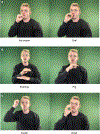Sign Language: How the Brain Represents Phonology without Sound
- PMID: 33202232
- PMCID: PMC8527985
- DOI: 10.1016/j.cub.2020.09.017
Sign Language: How the Brain Represents Phonology without Sound
Abstract
A rare case of a deaf signer undergoing awake craniotomy has revealed that sensorimotor cortex is functionally organized for signing. Electrocorticography recordings indicated neural tuning to linguistically-relevant handshapes and body locations and distinct neural activity for linguistic versus transitional movements.
Copyright © 2020 Elsevier Inc. All rights reserved.
Figures

Comment on
-
Cortical Encoding of Manual Articulatory and Linguistic Features in American Sign Language.Curr Biol. 2020 Nov 16;30(22):4342-4351.e3. doi: 10.1016/j.cub.2020.08.048. Epub 2020 Sep 3. Curr Biol. 2020. PMID: 32888480 Free PMC article.
References
-
- Brentari D (2019). Sign Language Phonology (Cambridge University Press; ).
-
- Thompson R, Emmorey K, and Gollan TH (2005). “Tip of the fingers” experiences by deaf signers: insights into the organization of a sign-based lexicon. Psych. Sci 16, 856–860. - PubMed
-
- Klima E, and Bellugi U (1979). The Signs of Language (Harvard University Press; ).
Publication types
MeSH terms
Grants and funding
LinkOut - more resources
Full Text Sources

